21 CFR Part 11 联邦法规21章第11款 主要规定内容涉及电子记录和电子签名
- 格式:doc
- 大小:32.00 KB
- 文档页数:2

【最新整理,下载后即可编辑】PART 11 Electronic Records; Electronic Signatures第11款电子记录;电子签名Subpart A--General Provisions分章A 一般规定Sec. 11.1 Scope.11.1适用范围(a) The regulations in this part set forth the criteria under which the agency considers electronic records, electronic signatures, and handwritten signatures executed to electronic records to be trustworthy, reliable, and generally equivalent to paper records and handwritten signatures executed on paper.本条款的规则提供了标准,在此标准之下FDA将认为电子记录、电子签名、和在电子记录上的手签名是可信赖的、可靠的并且通常等同于纸制记录和在纸上的手写签名。
(b) This part applies to records in electronic form that are created, modified, maintained, archived, retrieved, or transmitted, under any records requirements set forth in agency regulations.This part also applies to electronic records submitted to the agency under requirements of the Federal Food, Drug, and Cosmetic Act and the Public Health Service Act, even if such records are not specifically identified in agency regulations.However, this part does not apply to paper records that are, or have been, transmitted by electronic means.本条款适用于在FDA规则中阐明的在任何记录的要求下,以电子表格形式建立、修改、维护、归档、检索或传送的记录。
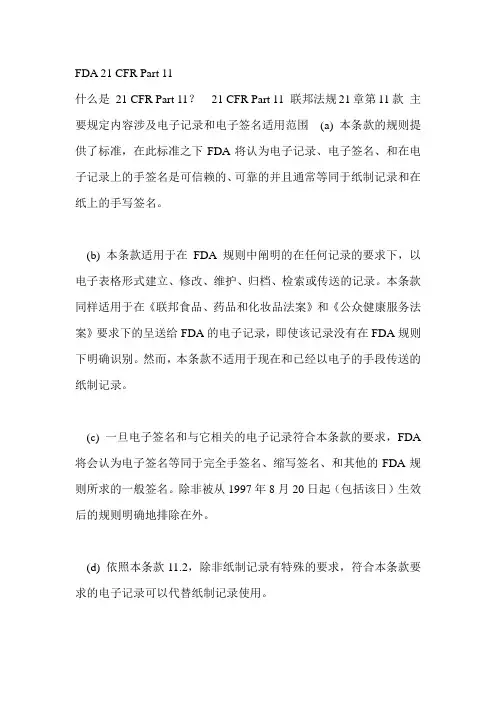
FDA 21 CFR Part 11什么是21 CFR Part 11?21 CFR Part 11 联邦法规21章第11款主要规定内容涉及电子记录和电子签名适用范围(a) 本条款的规则提供了标准,在此标准之下FDA将认为电子记录、电子签名、和在电子记录上的手签名是可信赖的、可靠的并且通常等同于纸制记录和在纸上的手写签名。
(b) 本条款适用于在FDA规则中阐明的在任何记录的要求下,以电子表格形式建立、修改、维护、归档、检索或传送的记录。
本条款同样适用于在《联邦食品、药品和化妆品法案》和《公众健康服务法案》要求下的呈送给FDA的电子记录,即使该记录没有在FDA规则下明确识别。
然而,本条款不适用于现在和已经以电子的手段传送的纸制记录。
(c) 一旦电子签名和与它相关的电子记录符合本条款的要求,FDA 将会认为电子签名等同于完全手签名、缩写签名、和其他的FDA规则所求的一般签名。
除非被从1997年8月20日起(包括该日)生效后的规则明确地排除在外。
(d) 依照本条款11.2,除非纸制记录有特殊的要求,符合本条款要求的电子记录可以代替纸制记录使用。
(e) 在本条款下维护计算机系统(包括硬件和软件)、控制权、和随附的文件应便于被FDA用到,和服从于FDA的监管。
履行(a) 需要维护,但不提交给FDA的记录,如果符合本条款的要求,人们可以使用全部或部分电子记录代替纸制记录或用电子签名代替传统签名。
(b) 提交给FDA的电子记录,人们可以使用全部或部分电子记录代替纸制记录或电子签名代替传统签名(手签名)假如:(1) 符合条款的要求(2) 提交的文件或部分文件,作为FDA以电子形式接收的提交物的类型已经被编号为92S-0251公共摘要识别出来。
这个摘要将明确地识别出,何种类型文件或部分文件在没有纸制记录和FDA接收单位(举例来说,特定的中心,办公室,部门、分支机构)时的电子形式提交物是可接受的。
如果没有在公共摘要上明确出来,他们以电子形式提交给FDA接收单位的文件将不被认为是正式的;这种文件的书面形式将被认为是正式的但必须伴有电子记录。

Agilent遵循21CFRPart11法规Agilent遵循21 CFR Part 11法规法规21章(21 CFR)第11部分包含了关于存储和保护电子结果以及应用电子签名的说明。
安捷伦公司的DS EZChrom 版本软件为公司客户提供一整套法规遵循服务,使色谱仪器的使用遵循该规定。
本文针对211的每一项进行检查,并对OpenLAB CDS EZChrom 版本提供的解决方案进行讨论。
电子记录11.10a 系统是否经过认证,以确保准确、可靠、性能稳定,并且具备识别无效或变更记录的能力是安捷伦公司进行了专门针对OpenLAB CDS EZChrom 版本准确性、可靠性和性能稳定了广泛而且深入的认证。
所有的数据、序列和方法均嵌入了审计跟踪,能够识别无效或变11.10b系统能否对所有要求的数据产生准确、完整的可读文档和电子文档,并且适合于FDA的是OpenLAB CDS EZChrom 版本通过一种独特的校验和算法(checksum algorithm)保些文件以及所产生的报告可用于审核和检查。
11.10c记录是否在整个保存期限内受到保护,以确保数据准确并且以备恢复?是所有的记录在安全的存储地址受到保护并且可以恢复。
对于长期的保护和存档,可以使用11.10d系统是否仅限于经过授权的个人使用?是OpenLAB CDS EZChrom 版本通过NT用户名和密码,对用户进行验证。
由系统管理能的权限。
11.10e 是否有安全的、计算机产生的、带时间标记的审记跟踪,能够独立记录操作者进入系统并记录等操作的日期和时间?是安全的、计算机产生的、带时间标记的审记跟踪嵌入数据本身以确保长期的保存和关联。
可以使用OpenLAB ECM。
11.10e当记录发生改变时,能留下更改以前的记录信息吗?是所有的改变均加入审计跟踪中,同时所有版本的数据和方法均得到保存。
信息不被重新覆11.10e电子审计跟踪记录是否能够至少与它们所隶属的电子记录保存相同的时间,并且能够让检是安全的、计算机产生的、带时间标记的审记跟踪嵌入数据本身,以确保长期的保存和关联11.10 (f)能否使用操作系统检查功能执行序列步骤和进程?是在OpenLAB CDS EZChrom 版本中,用户通过序列和进程循序操作。
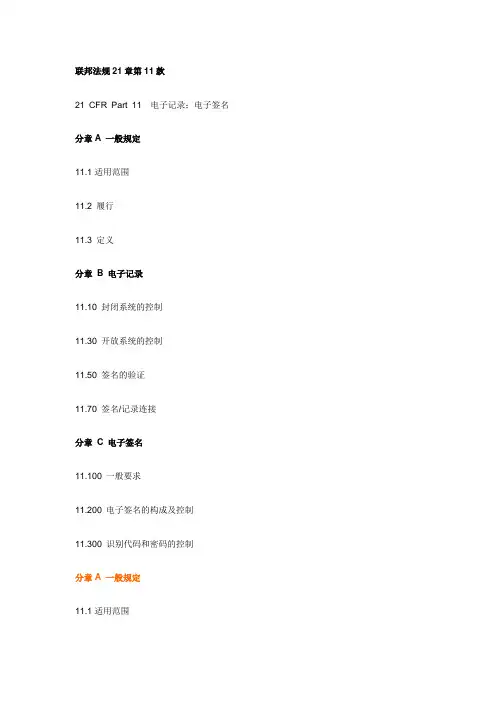
联邦法规21章第11款21 CFR Part 11 电子记录;电子签名分章A 一般规定11.1适用范围11.2 履行11.3 定义分章B 电子记录11.10 封闭系统的控制11.30 开放系统的控制11.50 签名的验证11.70 签名/记录连接分章C 电子签名11.100 一般要求11.200 电子签名的构成及控制11.300 识别代码和密码的控制分章A 一般规定11.1适用范围(a) 本条款的规则提供了标准,在此标准之下FDA将认为电子记录、电子签名、和在电子记录上的手签名是可信赖的、可靠的并且通常等同于纸制记录和在纸上的手写签名。
(b) 本条款适用于在FDA规则中阐明的在任何记录的要求下,以电子表格形式建立、修改、维护、归档、检索或传送的记录。
本条款同样适用于在《联邦食品、药品和化妆品法案》和《公众健康服务法案》要求下的呈送给FDA的电子记录,即使该记录没有在FDA规则下明确识别。
然而,本条款不适用于现在和已经以电子的手段传送的纸制记录。
(c) 一旦电子签名和与它相关的电子记录符合本条款的要求,FDA将会认为电子签名等同于完全手签名、缩写签名、和其他的FDA规则所求的一般签名。
除非被从1997年8月20日起(包括该日)生效后的规则明确地排除在外。
(d) 依照本条款11.2,除非纸制记录有特殊的要求,符合本条款要求的电子记录可以代替纸制记录使用。
(e) 在本条款下维护计算机系统(包括硬件和软件)、控制权、和随附的文件应便于被FD A用到,和服从于FDA的监管。
11.2履行(a) 需要维护,但不提交给FDA的记录,如果符合本条款的要求,人们可以使用全部或部分电子记录代替纸制记录或用电子签名代替传统签名。
(b) 提交给FDA的电子记录,人们可以使用全部或部分电子记录代替纸制记录或电子签名代替传统签名(手签名)假如:(1) 符合条款的要求;和(2) 提交的文件或部分文件,作为FDA以电子形式接收的提交物的类型已经被编号为92S-0251公共摘要识别出来。
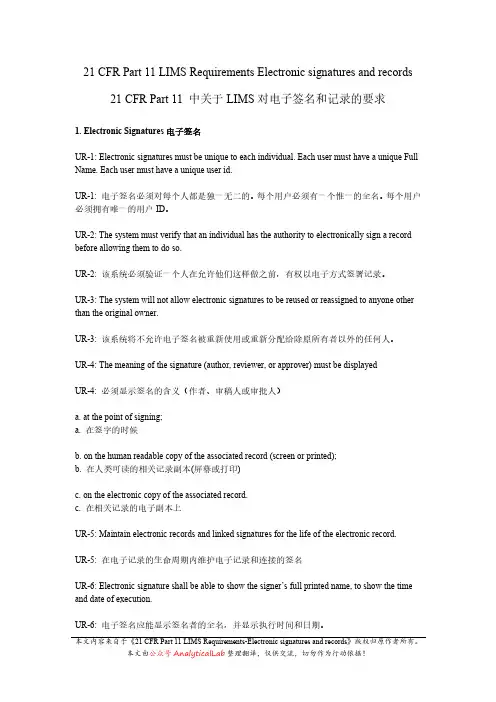
21 CFR Part 11 LIMS Requirements Electronic signatures and records21 CFR Part 11 中关于LIMS对电子签名和记录的要求1. Electronic Signatures电子签名UR-1: Electronic signatures must be unique to each individual. Each user must have a unique Full Name. Each user must have a unique user id.UR-1: 电子签名必须对每个人都是独一无二的。
每个用户必须有一个惟一的全名。
每个用户必须拥有唯一的用户ID。
UR-2: The system must verify that an individual has the authority to electronically sign a record before allowing them to do so.UR-2: 该系统必须验证一个人在允许他们这样做之前,有权以电子方式签署记录。
UR-3: The system will not allow electronic signatures to be reused or reassigned to anyone other than the original owner.UR-3: 该系统将不允许电子签名被重新使用或重新分配给除原所有者以外的任何人。
UR-4: The meaning of the signature (author, reviewer, or approver) must be displayedUR-4: 必须显示签名的含义(作者、审稿人或审批人)a. at the point of signing;a. 在签字的时候b. on the human readable copy of the associated record (screen or printed);b. 在人类可读的相关记录副本(屏幕或打印)c. on the electronic copy of the associated record.c. 在相关记录的电子副本上UR-5: Maintain electronic records and linked signatures for the life of the electronic record.UR-5: 在电子记录的生命周期内维护电子记录和连接的签名UR-6: Electronic signature shall be able to show the signer’s full printed name, to show the time and date of execution.UR-6: 电子签名应能显示签名者的全名,并显示执行时间和日期。
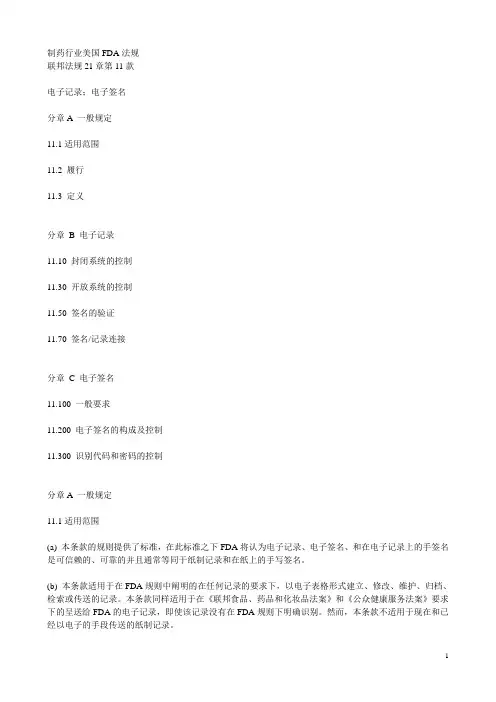
制药行业美国FDA法规联邦法规21章第11款电子记录;电子签名分章A 一般规定11.1适用范围11.2 履行11.3 定义分章B 电子记录11.10 封闭系统的控制11.30 开放系统的控制11.50 签名的验证11.70 签名/记录连接分章C 电子签名11.100 一般要求11.200 电子签名的构成及控制11.300 识别代码和密码的控制分章A 一般规定11.1适用范围(a) 本条款的规则提供了标准,在此标准之下FDA将认为电子记录、电子签名、和在电子记录上的手签名是可信赖的、可靠的并且通常等同于纸制记录和在纸上的手写签名。
(b) 本条款适用于在FDA规则中阐明的在任何记录的要求下,以电子表格形式建立、修改、维护、归档、检索或传送的记录。
本条款同样适用于在《联邦食品、药品和化妆品法案》和《公众健康服务法案》要求下的呈送给FDA的电子记录,即使该记录没有在FDA规则下明确识别。
然而,本条款不适用于现在和已经以电子的手段传送的纸制记录。
(c) 一旦电子签名和与它相关的电子记录符合本条款的要求,FDA将会认为电子签名等同于完全手签名、缩写签名、和其他的FDA规则所求的一般签名。
除非被从1997年8月20日起(包括该日)生效后的规则明确地排除在外。
(d) 依照本条款11.2,除非纸制记录有特殊的要求,符合本条款要求的电子记录可以代替纸制记录使用。
(e) 在本条款下维护计算机系统(包括硬件和软件)、控制权、和随附的文件应便于被FDA用到,和服从于FDA的监管。
11.2履行(a) 需要维护,但不提交给FDA的记录,如果符合本条款的要求,人们可以使用全部或部分电子记录代替纸制记录或用电子签名代替传统签名。
(b) 提交给FDA的电子记录,人们可以使用全部或部分电子记录代替纸制记录或电子签名代替传统签名(手签名)假如:(1) 符合条款的要求;和(2) 提交的文件或部分文件,作为FDA以电子形式接收的提交物的类型已经被编号为92S-0251公共摘要识别出来。

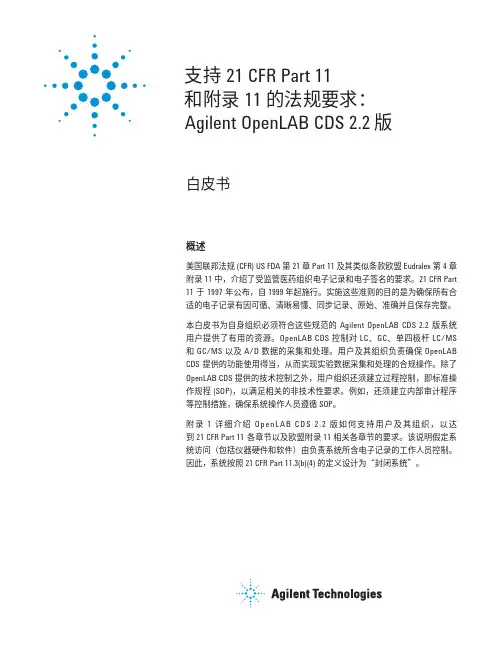
概述美国联邦法规 (CFR) US FDA 第 21 章 Part 11 及其类似条款欧盟 Eudralex 第 4 章 附录 11 中,介绍了受监管医药组织电子记录和电子签名的要求。
21 CFR Part11 于 1997 年公布,自 1999 年起施行。
实施这些准则的目的是为确保所有合适的电子记录有因可循、清晰易懂、同步记录、原始、准确并且保存完整。
本白皮书为自身组织必须符合这些规范的 Agilent OpenLAB CDS 2.2 版系统用户提供了有用的资源。
OpenLAB CDS 控制对 LC 、GC 、单四极杆 LC/MS和 GC/MS 以及 A/D 数据的采集和处理。
用户及其组织负责确保 OpenLAB CDS 提供的功能使用得当,从而实现实验数据采集和处理的合规操作。
除了 OpenLAB CDS 提供的技术控制之外,用户组织还须建立过程控制,即标准操作规程 (SOP),以满足相关的非技术性要求。
例如,还须建立内部审计程序等控制措施,确保系统操作人员遵循 SOP 。
附录 1 详细介绍 OpenLAB CDS 2.2 版如何支持用户及其组织,以达到 21 CFR Part 11 各章节以及欧盟附录 11 相关各章节的要求。
该说明假定系统访问(包括仪器硬件和软件)由负责系统所含电子记录的工作人员控制。
因此,系统按照 21 CFR Part 11.3(b)(4) 的定义设计为“封闭系统”。
支持 21 CFR Part 11和附录 11 的法规要求: Agilent OpenLAB CDS 2.2 版白皮书工作归因工作归因指记录执行工作的“人员、内容、时间、位置及原因”。
自动化审核追踪可独立记录用户操作,从而将实验室工作人员与其执行的工作联系起来。
通过审核追踪条目,工作人员和监管人员能够重建电子记录的完整历史。
• 人员:明确指出负责创建、修改或删除记录的特定操作的人员• 内容:指所执行的操作,包括记录中所含的旧值和新值(如果适用)• 时间:明确声明操作发生的日期和时间• 位置:明确指出受影响的记录• 原因:解释变更受监管记录的原因。

Agilent遵循21 CFR Part 11法规法规21章(21 CFR)第11部分包含了关于存储和保护电子结果以及应用电子签名的说明。
安捷伦公司的DS EZChrom 版本软件为公司客户提供一整套法规遵循服务,使色谱仪器的使用遵循该规定。
本文针对211的每一项进行检查,并对OpenLAB CDS EZChrom 版本提供的解决方案进行讨论。
电子记录11.10a 系统是否经过认证,以确保准确、可靠、性能稳定,并且具备识别无效或变更记录的能力是安捷伦公司进行了专门针对OpenLAB CDS EZChrom 版本准确性、可靠性和性能稳定了广泛而且深入的认证。
所有的数据、序列和方法均嵌入了审计跟踪,能够识别无效或变11.10b系统能否对所有要求的数据产生准确、完整的可读文档和电子文档,并且适合于FDA的是OpenLAB CDS EZChrom 版本通过一种独特的校验和算法(checksum algorithm)保些文件以及所产生的报告可用于审核和检查。
11.10c记录是否在整个保存期限内受到保护,以确保数据准确并且以备恢复?是所有的记录在安全的存储地址受到保护并且可以恢复。
对于长期的保护和存档,可以使用11.10d系统是否仅限于经过授权的个人使用?是OpenLAB CDS EZChrom 版本通过NT用户名和密码,对用户进行验证。
由系统管理能的权限。
11.10e 是否有安全的、计算机产生的、带时间标记的审记跟踪,能够独立记录操作者进入系统并记录等操作的日期和时间?是安全的、计算机产生的、带时间标记的审记跟踪嵌入数据本身以确保长期的保存和关联。
可以使用OpenLAB ECM。
11.10e当记录发生改变时,能留下更改以前的记录信息吗?是所有的改变均加入审计跟踪中,同时所有版本的数据和方法均得到保存。
信息不被重新覆11.10e电子审计跟踪记录是否能够至少与它们所隶属的电子记录保存相同的时间,并且能够让检是安全的、计算机产生的、带时间标记的审记跟踪嵌入数据本身,以确保长期的保存和关联11.10 (f)能否使用操作系统检查功能执行序列步骤和进程?是在OpenLAB CDS EZChrom 版本中,用户通过序列和进程循序操作。
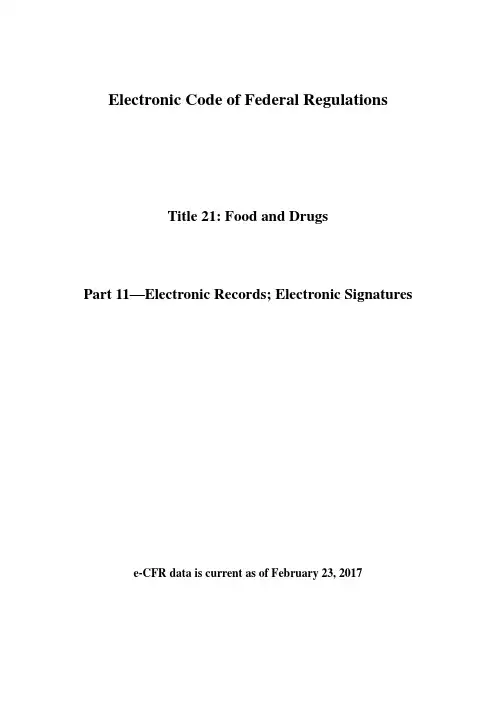
Electronic Code of Federal RegulationsTitle 21: Food and DrugsPart 11—Electronic Records; Electronic Signatures e-CFR data is current as of February 23, 2017ContentsSubpart A—General Provisions§11.1 Scope.§11.2 Implementation.§11.3 Definitions.Subpart B—Electronic Records§11.10 Controls for closed systems.§11.30 Controls for open systems.§11.50 Signature manifestations.§11.70 Signature/record linking.Subpart C—Electronic Signatures§11.100 General requirements.§11.200 Electronic signature components and controls.§11.300 Controls for identification codes/passwords.Authority: 21 U.S.C. 321-393; 42 U.S.C. 262.Source: 62 FR 13464, Mar. 20, 1997, unless otherwise noted.Subpart A—General Provisions§11.1 Scope.(a) The regulations in this part set forth the criteria under which the agency considers electronic records, electronic signatures, and handwritten signatures executed to electronic records to be trustworthy, reliable, and generally equivalent to paper records and handwritten signatures executed on paper.(b) This part applies to records in electronic form that are created, modified, maintained, archived, retrieved, or transmitted, under any records requirements set forth in agency regulations. This part also applies to electronic records submitted to the agency under requirements of the Federal Food, Drug, and Cosmetic Act and the Public Health Service Act, even if such records are not specifically identified in agency regulations. However, this part does not apply to paper records that are, or have been, transmitted by electronic means.(c) Where electronic signatures and their associated electronic records meet the requirements of this part, the agency will consider the electronic signatures to be equivalent to full handwritten signatures, initials, and other general signings as required by agency regulations, unless specifically excepted by regulation(s) effective on or after August 20, 1997.(d) Electronic records that meet the requirements of this part may be used in lieu of paper records, in accordance with §11.2, unless paper records are specifically required.(e) Computer systems (including hardware and software), controls, and attendant documentation maintained under this part shall be readily available for, and subject to, FDA inspection.(f) This part does not apply to records required to be established or maintained by §§1.326 through 1.368 of this chapter. Records that satisfy the requirements of part 1, subpart J of this chapter, but that also are required under other applicable statutory provisions or regulations, remain subject to this part.(g) This part does not apply to electronic signatures obtained under §101.11(d) ofthis chapter.(h) This part does not apply to electronic signatures obtained under §101.8(d) of this chapter.(i) This part does not apply to records required to be established or maintained by part 117 of this chapter. Records that satisfy the requirements of part 117 of this chapter, but that also are required under other applicable statutory provisions or regulations, remain subject to this part.(j) This part does not apply to records required to be established or maintained by part 507 of this chapter. Records that satisfy the requirements of part 507 of this chapter, but that also are required under other applicable statutory provisions or regulations, remain subject to this part.(k) This part does not apply to records required to be established or maintained by part 112 of this chapter. Records that satisfy the requirements of part 112 of this chapter, but that also are required under other applicable statutory provisions or regulations, remain subject to this part.(l) This part does not apply to records required to be established or maintained by subpart L of part 1 of this chapter. Records that satisfy the requirements of subpart L of part 1 of this chapter, but that also are required under other applicable statutory provisions or regulations, remain subject to this part.(m) This part does not apply to records required to be established or maintained by subpart M of part 1 of this chapter. Records that satisfy the requirements of subpart M of part 1 of this chapter, but that also are required under other applicable statutory provisions or regulations, remain subject to this part.(n) This part does not apply to records required to be established or maintained by subpart O of part 1 of this chapter. Records that satisfy the requirements of subpart O of part 1 of this chapter, but that also are required under other applicable statutory provisions or regulations, remain subject to this part.(o) This part does not apply to records required to be established or maintained by part 121 of this chapter. Records that satisfy the requirements of part 121 of this chapter, but that also are required under other applicable statutory provisions or regulations,remain subject to this part.[62 FR 13464, Mar. 20, 1997, as amended at 69 FR 71655, Dec. 9, 2004; 79 FR 71253, 71291, Dec. 1, 2014; 80 FR 71253, June 19, 2015; 80 FR 56144, 56336, Sept. 17, 2015; 80 FR 74352, 74547, 74667, Nov. 27, 2015; 81 FR 20170, Apr. 6, 2016; 81 FR 34218, May 27, 2016]§11.2 Implementation.(a) For records required to be maintained but not submitted to the agency, persons may use electronic records in lieu of paper records or electronic signatures in lieu of traditional signatures, in whole or in part, provided that the requirements of this part are met.(b) For records submitted to the agency, persons may use electronic records in lieu of paper records or electronic signatures in lieu of traditional signatures, in whole or in part, provided that:(1) The requirements of this part are met; and(2) The document or parts of a document to be submitted have been identifiedin public docket No. 92S-0251 as being the type of submission the agency accepts in electronic form. This docket will identify specifically what types of documents or parts of documents are acceptable for submission in electronic form without paper records and the agency receiving unit(s) (e.g., specific center, office, division, branch) to which such submissions may be made. Documents to agency receiving unit(s) not specified in the public docket will not be considered as official if they are submitted in electronic form; paper forms of such documents will be considered as official and must accompany any electronic records. Persons are expected to consult with the intended agency receiving unit for details on how (e.g., method of transmission, media, file formats, and technical protocols) and whether to proceed with the electronic submission.§11.3 Definitions.(a) The definitions and interpretations of terms contained in section 201 of the act apply to those terms when used in this part.(b) The following definitions of terms also apply to this part:(1) Act means the Federal Food, Drug, and Cosmetic Act (secs. 201-903 (21 U.S.C. 321-393)).(2) Agency means the Food and Drug Administration.(3) Biometrics means a method of verifying an individual's identity based on measurement of the individual's physical feature(s) or repeatable action(s) where those features and/or actions are both unique to that individual and measurable.(4) Closed system means an environment in which system access is controlled by persons who are responsible for the content of electronic records that are on the system.(5) Digital signature means an electronic signature based upon cryptographic methods of originator authentication, computed by using a set of rules and a set of parameters such that the identity of the signer and the integrity of the data can be verified.(6) Electronic record means any combination of text, graphics, data, audio, pictorial, or other information representation in digital form that is created, modified, maintained, archived, retrieved, or distributed by a computer system.(7) Electronic signature means a computer data compilation of any symbol or series of symbols executed, adopted, or authorized by an individual to be the legally binding equivalent of the individual's handwritten signature.(8) Handwritten signature means the scripted name or legal mark of an individual handwritten by that individual and executed or adopted with the present intention to authenticate a writing in a permanent form. The act of signing with a writing or marking instrument such as a pen or stylus is preserved. The scripted name or legal mark, while conventionally applied to paper, may also be applied to other devices that capture the name or mark.(9) Open system means an environment in which system access is not controlled by persons who are responsible for the content of electronic records that are on the system.Subpart B—Electronic Records§11.10 Controls for closed systems.Persons who use closed systems to create, modify, maintain, or transmit electronic records shall employ procedures and controls designed to ensure the authenticity, integrity, and, when appropriate, the confidentiality of electronic records, and to ensure that the signer cannot readily repudiate the signed record as not genuine. Such procedures and controls shall include the following:(a) Validation of systems to ensure accuracy, reliability, consistent intended performance, and the ability to discern invalid or altered records.(b) The ability to generate accurate and complete copies of records in both human readable and electronic form suitable for inspection, review, and copying by the agency. Persons should contact the agency if there are any questions regarding the ability of the agency to perform such review and copying of the electronic records.(c) Protection of records to enable their accurate and ready retrieval throughout the records retention period.(d) Limiting system access to authorized individuals.(e) Use of secure, computer-generated, time-stamped audit trails to independently record the date and time of operator entries and actions that create, modify, or delete electronic records. Record changes shall not obscure previously recorded information. Such audit trail documentation shall be retained for a period at least as long as that required for the subject electronic records and shall be available for agency review and copying.(f) Use of operational system checks to enforce permitted sequencing of steps and events, as appropriate.(g) Use of authority checks to ensure that only authorized individuals can use the system, electronically sign a record, access the operation or computer system input or output device, alter a record, or perform the operation at hand.(h) Use of device (e.g., terminal) checks to determine, as appropriate, the validity of the source of data input or operational instruction.(i) Determination that persons who develop, maintain, or use electronic record/electronic signature systems have the education, training, and experience to perform their assigned tasks.(j) The establishment of, and adherence to, written policies that hold individuals accountable and responsible for actions initiated under their electronic signatures, in order to deter record and signature falsification.(k) Use of appropriate controls over systems documentation including:(1) Adequate controls over the distribution of, access to, and use ofdocumentation for system operation and maintenance.(2) Revision and change control procedures to maintain an audit trail thatdocuments time-sequenced development and modification of systems documentation.§11.30 Controls for open systems.Persons who use open systems to create, modify, maintain, or transmit electronic records shall employ procedures and controls designed to ensure the authenticity, integrity, and, as appropriate, the confidentiality of electronic records from the point of their creation to the point of their receipt. Such procedures and controls shall include those identified in §11.10, as appropriate, and additional measures such as document encryption and use of appropriate digital signature standards to ensure, as necessary under the circumstances, record authenticity, integrity, and confidentiality.§11.50 Signature manifestations.(a) Signed electronic records shall contain information associated with the signing that clearly indicates all of the following:(1) The printed name of the signer;(2) The date and time when the signature was executed; and(3) The meaning (such as review, approval, responsibility, or authorship)associated with the signature.(b) The items identified in paragraphs (a)(1), (a)(2), and (a)(3) of this sectionshall be subject to the same controls as for electronic records and shall be includedas part of any human readable form of the electronic record (such as electronic display or printout).§11.70 Signature/record linking.Electronic signatures and handwritten signatures executed to electronic records shall be linked to their respective electronic records to ensure that the signatures cannot be excised, copied, or otherwise transferred to falsify an electronic record by ordinary means.Subpart C—Electronic Signatures§11.100 General requirements.(a) Each electronic signature shall be unique to one individual and shall not be reused by, or reassigned to, anyone else.(b) Before an organization establishes, assigns, certifies, or otherwise sanctions an individual's electronic signature, or any element of such electronic signature, the organization shall verify the identity of the individual.(c) Persons using electronic signatures shall, prior to or at the time of such use, certify to the agency that the electronic signatures in their system, used on or after August 20, 1997, are intended to be the legally binding equivalent of traditional handwritten signatures.(1) The certification shall be submitted in paper form and signed with atraditional handwritten signature, to the Office of Regional Operations (HFC-100), 5600 Fishers Lane, Rockville, MD 20857.(2) Persons using electronic signatures shall, upon agency request, provideadditional certification or testimony that a specific electronic signature is the legally binding equivalent of the signer's handwritten signature.§11.200 Electronic signature components and controls.(a) Electronic signatures that are not based upon biometrics shall:(1) Employ at least two distinct identification components such as anidentification code and password.(i) When an individual executes a series of signings during a single,continuous period of controlled system access, the first signing shall beexecuted using all electronic signature components; subsequent signings shallbe executed using at least one electronic signature component that is onlyexecutable by, and designed to be used only by, the individual.(ii) When an individual executes one or more signings not performed during a single, continuous period of controlled system access, each signingshall be executed using all of the electronic signature components.(2) Be used only by their genuine owners; and(3) Be administered and executed to ensure that attempted use of anindividual's electronic signature by anyone other than its genuine owner requires collaboration of two or more individuals.(b) Electronic signatures based upon biometrics shall be designed to ensure that they cannot be used by anyone other than their genuine owners.§11.300 Controls for identification codes/passwords.Persons who use electronic signatures based upon use of identification codes in combination with passwords shall employ controls to ensure their security and integrity. Such controls shall include:(a) Maintaining the uniqueness of each combined identification code and password, such that no two individuals have the same combination of identification code and password.(b) Ensuring that identification code and password issuances are periodically checked, recalled, or revised (e.g., to cover such events as password aging).(c) Following loss management procedures to electronically deauthorize lost, stolen, missing, or otherwise potentially compromised tokens, cards, and other devices that bear or generate identification code or password information, and to issue temporary or permanent replacements using suitable, rigorous controls.(d) Use of transaction safeguards to prevent unauthorized use of passwords and/or identification codes, and to detect and report in an immediate and urgent manner anyattempts at their unauthorized use to the system security unit, and, as appropriate, to organizational management.(e) Initial and periodic testing of devices, such as tokens or cards, that bear or generate identification code or password information to ensure that they function properly and have not been altered in an unauthorized manner.11 / 11。
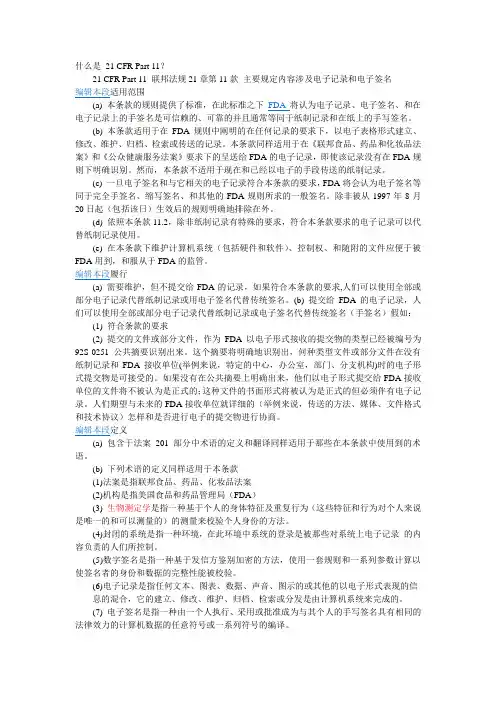
什么是21 CFR Part 11?21 CFR Part 11 联邦法规21章第11款主要规定内容涉及电子记录和电子签名编辑本段适用范围(a) 本条款的规则提供了标准,在此标准之下FDA将认为电子记录、电子签名、和在电子记录上的手签名是可信赖的、可靠的并且通常等同于纸制记录和在纸上的手写签名。
(b) 本条款适用于在FDA规则中阐明的在任何记录的要求下,以电子表格形式建立、修改、维护、归档、检索或传送的记录。
本条款同样适用于在《联邦食品、药品和化妆品法案》和《公众健康服务法案》要求下的呈送给FDA的电子记录,即使该记录没有在FDA规则下明确识别。
然而,本条款不适用于现在和已经以电子的手段传送的纸制记录。
(c) 一旦电子签名和与它相关的电子记录符合本条款的要求,FDA将会认为电子签名等同于完全手签名、缩写签名、和其他的FDA规则所求的一般签名。
除非被从1997年8月20日起(包括该日)生效后的规则明确地排除在外。
(d) 依照本条款11.2,除非纸制记录有特殊的要求,符合本条款要求的电子记录可以代替纸制记录使用。
(e) 在本条款下维护计算机系统(包括硬件和软件)、控制权、和随附的文件应便于被FDA用到,和服从于FDA的监管。
编辑本段履行(a) 需要维护,但不提交给FDA的记录,如果符合本条款的要求,人们可以使用全部或部分电子记录代替纸制记录或用电子签名代替传统签名。
(b) 提交给FDA的电子记录,人们可以使用全部或部分电子记录代替纸制记录或电子签名代替传统签名(手签名)假如:(1) 符合条款的要求(2) 提交的文件或部分文件,作为FDA以电子形式接收的提交物的类型已经被编号为92S-0251公共摘要识别出来。
这个摘要将明确地识别出,何种类型文件或部分文件在没有纸制记录和FDA接收单位(举例来说,特定的中心,办公室,部门、分支机构)时的电子形式提交物是可接受的。
如果没有在公共摘要上明确出来,他们以电子形式提交给FDA接收单位的文件将不被认为是正式的;这种文件的书面形式将被认为是正式的但必须伴有电子记录。
联邦法典21章第11莭21 CFR Part 11电子记录;电子签名分章A 一般规定11.1适用范围11.2 履行11.3 定义分章 B 电子记录11.10 封闭系统的控制11.30 开放系统的控制11.50 签名的验证11.70 签名/记录连接分章 C 电子签名11.100 一般要求11.200 电子签名的构成及控制11.300 识别代码和密码的控制分章A 一般规定11.1适用范围(a) 本条款的规则提供了标准,在此标准之下FDA将认为电子记录、电子签名、和在电子记录上的手签名是可信赖的、可靠的并且通常等同于纸制记录和在纸上的手写签名。
(b) 本条款适用于在FDA规则中阐明的在任何记录的要求下,以电子表格形式建立、修改、维护、归档、检索或传送的记录。
本条款同样适用于在《联邦食品、药品和化妆品法案》和《公众健康服务法案》要求下的呈送给FDA的电子记录,即使该记录没有在FDA规则下明确识别。
然而,本条款不适用于现在和已经以电子的手段传送的纸制记录。
(c) 一旦电子签名和与它相关的电子记录符合本条款的要求,FDA将会认为电子签名等同于完全手签名、缩写签名、和其他的FDA规则所求的一般签名。
除非被从1997年8月20日起(包括该日)生效后的规则明确地排除在外。
(d) 依照本条款11.2,除非纸制记录有特殊的要求,符合本条款要求的电子记录可以代替纸制记录使用。
(e) 在本条款下维护计算机系统(包括硬件和软件)、控制权、和随附的文件应便于被FDA用到,和服从于FDA的监管。
11.2履行(a) 需要维护,但不提交给FDA的记录,如果符合本条款的要求,人们可以使用全部或部分电子记录代替纸制记录或用电子签名代替传统签名。
(b) 提交给FDA的电子记录,人们可以使用全部或部分电子记录代替纸制记录或电子签名代替传统签名(手签名)假如:(1) 符合条款的要求;和(2) 提交的文件或部分文件,作为FDA以电子形式接收的提交物的类型已经被编号为92S-0251公共摘要识别出来。
Title 21 → Chapter I→ Subchapter A →Part11TITLE 21—Food and Drugs食品和药品CHAPTER I—FOOD AND DRUG ADMINISTRATION, DEPARTMENT OF HEALTHAND HUMAN SERVICES 食品药品管理局,卫生福利部SUBCHAPTER A—GENERAL通则PART 11—ELECTRONIC RECORDS; ELECTRONIC SIGNATURES电子记录,电子签名Sec. 11.1 Scope.范围(a)The regulations in this part set forth the criteria under which the agency considers electronicrecords, electronic signatures, and handwritten signatures executed to electronic records to be trustworthy, reliable, and generally equivalent to paper records and handwritten signatures executed on paper.本部分的规定设定了FDA认为电子记录、电子签名和对电子记录所实施的手写签名可靠可信,并且通常等同于纸质记录和在纸上手书签名的标准。
(b)This part applies to records in electronic form that are created, modified, maintained, archived,retrieved, or transmitted, under any records requirements set forth in agency regulations. This part also applies to electronic records submitted to the agency under requirements of the Federal Food, Drug, and Cosmetic Act and the Public Health Service Act, even if such records are not specifically identified in agency regulations. However, this part does not apply to paper records that are, or have been, transmitted by electronic means.本部分适用于依FDA法规中设定的记录要求创建、修改、维护、归档、检索或传送的电子形式记录。
Help | More About 21CFR [Code of Federal Regulations][Title 21, Volume 1][Revised as of April 1, 2006][CITE: 21CFR 11]TITLE 21--FOOD AND DRUGSCHAPTER I--FOOD AND DRUG ADMINISTRATIONDEPARTMENT OF HEALTH AND HUMAN SERVICESSUBCHAPTER A--GENERALPART 11 ELECTRONIC RECORDS; ELECTRONICSIGNATURESSubpart A--General ProvisionsSec. 11.1 Scope.(a) The regulations in this part set forth the criteria under which the agency considers electronic records, electronic signatures, and handwritten signatures executed to electronic records to be trustworthy, reliable, and generally equivalent to paper records and handwritten signatures executed on paper.(b) This part applies to records in electronic form that are created, modified, maintained, archived, retrieved, or transmitted, under any records requirements set forth in agency regulations. This part also applies to electronic records submitted to the agency under requirements of the Federal Food, Drug, and Cosmetic Act and the Public Health Service Act, even if such records are not specifically identified in agency regulations. However, this part does not apply to paper records that are, or have been, transmitted by electronic means.(c) Where electronic signatures and their associated electronic records meet the requirements of this part, the agency will consider the electronic signatures to be equivalent to full handwritten signatures, initials, and other general signings as required by agency regulations, unless specifically excepted by regulation(s) effective on or after August 20, 1997.(d) Electronic records that meet the requirements of this part may be used in lieu of paper records, in accordance with 11.2, unless paper records are specifically required.(e) Computer systems (including hardware and software), controls, and attendant documentation maintained under this part shall be readily available for, and subject to, FDA inspection.(f) This part does not apply to records required to be established or maintained by 1.326 through 1.368 of this chapter. Records that satisfy the requirements of part 1, subpart J of this chapter, but that also are required under other applicable statutory provisions or regulations, remain subject to this part.[62 FR 13464, Mar. 20, 1997, as amended at 69 FR 71655, Dec. 9, 2004]Sec. 11.2 Implementation.(a) For records required to be maintained but not submitted to the agency, persons may use electronic records in lieu of paper records or electronic signatures in lieu of traditional signatures, in whole or in part, provided that the requirements of this part are met.(b) For records submitted to the agency, persons may use electronic records in lieu of paper records or electronic signatures in lieu of traditional signatures, in whole or in part, provided that:(1) The requirements of this part are met; and(2) The document or parts of a document to be submitted have been identified in public docket No. 92S-0251 as being the type of submission the agency accepts in electronic form. This docket will identify specifically what types of documents or parts of documents are acceptable for submission in electronic form without paper records and the agency receiving unit(s) (e.g., specific center, office, division, branch) to which such submissions may be made. Documents to agency receiving unit(s) not specified in the public docket will not be considered as official if they are submitted in electronicform; paper forms of such documents will be considered as official and must accompany any electronic records. Persons are expected to consult with the intended agency receiving unit for details on how (e.g., method of transmission, media, file formats, and technical protocols) and whether to proceed with the electronic submission.Sec. 11.3 Definitions.(a) The definitions and interpretations of terms contained in section 201 of the act apply to those terms when used in this part.(b) The following definitions of terms also apply to this part:(1) Act means the Federal Food, Drug, and Cosmetic Act (secs. 201-903 (21 U.S.C. 321-393)).(2) Agency means the Food and Drug Administration.(3) Biometrics means a method of verifying an individual's identity based on measurement of the individual's physical feature(s) or repeatable action(s) where those features and/or actions are both unique to that individual and measurable.(4) Closed system means an environment in which system access is controlled by persons who are responsible for the content of electronic records that are on the system.(5) Digital signature means an electronic signature based upon cryptographic methods of originator authentication, computed by using a set of rules and a set of parameters such that the identity of the signer and the integrity of the data can be verified.(6) Electronic record means any combination of text, graphics, data, audio, pictorial, or other information representation in digital form that is created, modified, maintained, archived, retrieved, or distributed by a computer system.(7) Electronic signature means a computer data compilation of any symbol or series of symbols executed, adopted, or authorized by an individual to be the legally bindingequivalent of the individual's handwritten signature.(8) Handwritten signature means the scripted name or legal mark of an individual handwritten by that individual and executed or adopted with the present intention to authenticate a writing in a permanent form. The act of signing with a writing or marking instrument such as a pen or stylus is preserved. The scripted name or legal mark, while conventionally applied to paper, may also be applied to other devices that capture the name or mark.(9) Open system means an environment in which system access is not controlled by persons who are responsible for the content of electronic records that are on the system. Subpart B--Electronic RecordsSec. 11.10 Controls for closed systems.Persons who use closed systems to create, modify, maintain, or transmit electronic records shall employ procedures and controls designed to ensure the authenticity, integrity, and, when appropriate, the confidentiality of electronic records, and to ensure that the signer cannot readily repudiate the signed record as not genuine. Such procedures and controls shall include the following:(a) Validation of systems to ensure accuracy, reliability, consistent intended performance, and the ability to discern invalid or altered records.(b) The ability to generate accurate and complete copies of records in both human readable and electronic form suitable for inspection, review, and copying by the agency. Persons should contact the agency if there are any questions regarding the ability of the agency to perform such review and copying of the electronic records.(c) Protection of records to enable their accurate and ready retrieval throughout the records retention period.(d) Limiting system access to authorized individuals.(e) Use of secure, computer-generated, time-stamped audit trails to independently record the date and time of operatorentries and actions that create, modify, or delete electronic records. Record changes shall not obscure previously recorded information. Such audit trail documentation shall be retained for a period at least as long as that required for the subject electronic records and shall be available for agency review and copying.(f) Use of operational system checks to enforce permitted sequencing of steps and events, as appropriate.(g) Use of authority checks to ensure that only authorized individuals can use the system, electronically sign a record, access the operation or computer system input or output device, alter a record, or perform the operation at hand.(h) Use of device (e.g., terminal) checks to determine, as appropriate, the validity of the source of data input or operational instruction.(i) Determination that persons who develop, maintain, or use electronic record/electronic signature systems have the education, training, and experience to perform their assigned tasks.(j) The establishment of, and adherence to, written policies that hold individuals accountable and responsible for actions initiated under their electronic signatures, in order to deter record and signature falsification.(k) Use of appropriate controls over systems documentation including:(1) Adequate controls over the distribution of, access to, and use of documentation for system operation and maintenance.(2) Revision and change control procedures to maintain an audit trail that documents time-sequenced development and modification of systems documentation.Sec. 11.30 Controls for open systems.Persons who use open systems to create, modify, maintain, or transmit electronic records shall employ procedures and controls designed to ensure the authenticity, integrity, and,as appropriate, the confidentiality of electronic records from the point of their creation to the point of their receipt. Such procedures and controls shall include those identified in 11.10, as appropriate and additional measures such as document encryption and use of appropriate digital signature standards to ensure, as necessary under the circumstances, record authenticity, integrity, and confidentiality.Sec. 11.50 Signature manifestations.(a) Signed electronic records shall contain information associated with the signing that clearly indicates all of the following:(1) The printed name of the signer;(2) The date and time when the signature was executed; and(3) The meaning (such as review, approval, responsibility, or authorship) associated with the signature.(b) The items identified in paragraphs (a)(1), (a)(2), and (a)(3) of this section shall be subject to the same controls as for electronic records and shall be included as part of any human readable form of the electronic record (such as electronic display or printout).Sec. 11.70 Signature/record linking.Electronic signatures and handwritten signatures executed to electronic records shall be linked to their respective electronic records to ensure that the signatures cannot be excised, copied, or otherwise transferred to falsify an electronic record by ordinary means.Subpart C--Electronic SignaturesSec. 11.100 General requirements.(a) Each electronic signature shall be unique to one individual and shall not be reused by, or reassigned to, anyone else.(b) Before an organization establishes, assigns, certifies,or otherwise sanctions an individual's electronic signature, or any element of such electronic signature, the organization shall verify the identity of the individual.(c) Persons using electronic signatures shall, prior to or at the time of such use, certify to the agency that the electronic signatures in their system, used on or after August 20, 1997, are intended to be the legally binding equivalent of traditional handwritten signatures.(1) The certification shall be submitted in paper form and signed with a traditional handwritten signature, to the Office of Regional Operations (HFC-100), 5600 Fishers Lane, Rockville, MD 20857.(2) Persons using electronic signatures shall, upon agency request, provide additional certification or testimony that a specific electronic signature is the legally binding equivalent of the signer's handwritten signature.Sec. 11.200 Electronic signature components and controls.(a) Electronic signatures that are not based upon biometrics shall:(1) Employ at least two distinct identification components such as an identification code and password.(i) When an individual executes a series of signings during a single, continuous period of controlled system access, the first signing shall be executed using all electronic signature components; subsequent signings shall be executed using at least one electronic signature component that is only executable by, and designed to be used only by, the individual. (ii) When an individual executes one or more signings not performed during a single, continuous period of controlled system access, each signing shall be executed using all of the electronic signature components.(2) Be used only by their genuine owners; and(3) Be administered and executed to ensure that attempted use of an individual's electronic signature by anyone other thanits genuine owner requires collaboration of two or more individuals.(b) Electronic signatures based upon biometrics shall be designed to ensure that they cannot be used by anyone other than their genuine owners.Sec. 11.300 Controls for identification codes/passwords.Persons who use electronic signatures based upon use of identification codes in combination with passwords shall employ controls to ensure their security and integrity. Such controls shall include:(a) Maintaining the uniqueness of each combined identification code and password, such that no two individuals have the same combination of identification code and password.(b) Ensuring that identification code and password issuances are periodically checked, recalled, or revised (e.g., to cover such events as password aging).(c) Following loss management procedures to electronically deauthorize lost, stolen, missing, or otherwise potentially compromised tokens, cards, and other devices that bear or generate identification code or password information, and to issue temporary or permanent replacements using suitable, rigorous controls.(d) Use of transaction safeguards to prevent unauthorized use of passwords and/or identification codes, and to detect and report in an immediate and urgent manner any attempts at their unauthorized use to the system security unit, and, as appropriate, to organizational management.(e) Initial and periodic testing of devices, such as tokens or cards, that bear or generate identification code or password information to ensure that they function properly and have not been altered in an unauthorized manner.Authority: 21 U.S.C. 321-393; 42 U.S.C. 262.Source: 62 FR 13464, Mar. 20, 1997, unless otherwise noted.PART 11 电子记录;电子签名分章 A 一般规定11.1 适用范围11.2 履行11.3 定义分章 B 电子记录11.10 封闭系统的控制11.30 开放系统的控制11.50 签名的验证11.70 签名/记录连接分章 C 电子签名11.100 一般要求11.200 电子签名的构成及控制11.300 识别代码和密码的控制分章A 一般规定11.1适用范围(a) 这部分内容条款规定了标准,在此标准之下FDA将认为电子记录、电子签名、和在电子记录上的手写签名是可信赖的、可靠的,并且通常等同于纸面记录和在纸面记录上的手写签名。
1.什么是FDA 21 CFR Part 11?FDA 21 CFR Part 11是美国在1997年8月颁布的一项FDA的规定,属于美国联邦法规第21章第11款,主要规定内容涉及电子记录和电子签名适用范围. 适用于FDA监管工作中的电子记录以及在其上的电子签名。
在规定中,电子记录、电子签名被认为具有与书面记录和手写签名同等的效力。
此法规确保了电子数据的有效性和可靠性。
2.FDA,CFR解释FDA:美国食品和药物管理局(Food and Drug Administration)简称FDA,FDA 是美国政府在健康与人类服务部(DHHS) 和公共卫生部(PHS) 中设立的执行机构之一。
作为一家科学管理机构,FDA 的职责是确保美国本国生产或进口的食品、化妆品、药物、生物制剂、医疗设备和放射产品的安全。
它是最早以保护消费者为主要职能的联邦机构之一。
CFR:《美国联邦法规》Code of Federal Regulations3.FDA 21 CFR Part 11实际应用实际应用常以符合FDA 21 CFR Part 11 方式表达。
食品、医药制造行业多遵照此标准。
只有遵照此标准,其厂商生产的产品才可以正常销往国外市场;并且遵照此标准而保留的数据才可以作为通过检验或者今后追溯的有效数据来源。
4.关于FDA 21 CFR Part 11认证的理解1.FDA 21 CFR Part 11是没有FDA或第三方权威机构的认证的,本身是一个法律,只有遵照执行。
2. 严格来讲并没有FDA认证的叫法,不过一般大家所说的FDA认证主要指以下两种:1、FDA注册:很多产品销售到美国需要的进行注册的(如食品,药品,医疗器械,激光产品等),有些产品还必须要做过检测才能申请注册。
2、FDA检测:就是按照FDA法规对产品进行测试。
5.FDA 21 CFR Part 11 内容解读具体内容请参考文件“联邦法规21章第11款.doc”。
联邦法规21章第11款21CFR Part11联邦法规21章第11款21CFR Part11电子记录;电子签名分章A一般规定11.1适用范围11.2履行11.3定义分章B电子记录11.10封闭系统的控制11.30开放系统的控制11.50签名的验证11.70签名/记录连接分章C电子签名11.100一般要求11.200电子签名的构成及控制11.300识别代码和密码的控制分章A一般规定11.1适用范围(a)本条款的规则提供了标准,在此标准之下FDA将认为电子记录、电子签名、和在电子记录上的手签名是可信赖的、可靠的并且通常等同于纸制记录和在纸上的手写签名。
(b)本条款适用于在FDA规则中阐明的在任何记录的要求下,以电子表格形式建立、修改、维护、归档、检索或传送的记录。
本条款同样适用于在《联邦食品、药品和化妆品法案》和《公众健康服务法案》要求下的呈送给FDA的电子记录,即使该记录没有在FDA规则下明确识别。
然而,本条款不适用于现在和已经以电子的手段传送的纸制记录。
(c)一旦电子签名和与它相关的电子记录符合本条款的要求,FDA将会认为电子签名等同于完全手签名、缩写签名、和其他的FDA规则所求的一般签名。
除非被从1997年8月20日起(包括该日)生效后的规则明确地排除在外。
(d)依照本条款11.2,除非纸制记录有特殊的要求,符合本条款要求的电子记录可以代替纸制记录使用。
(e)在本条款下维护计算机系统(包括硬件和软件)、控制权、和随附的文件应便于被FDA 用到,和服从于FDA的监管。
11.2履行(a)需要维护,但不提交给FDA的记录,如果符合本条款的要求,人们可以使用全部或部分电子记录代替纸制记录或用电子签名代替传统签名。
(b)提交给FDA的电子记录,人们可以使用全部或部分电子记录代替纸制记录或电子签名代替传统签名(手签名)假如:(1)符合条款的要求;和(2)提交的文件或部分文件,作为FDA以电子形式接收的提交物的类型已经被编号为92S-0251公共摘要识别出来。
21CFR-part11-中文版资料联邦法规21章第11款电子记录;电子签名分章A 一般规定11.1适用范围11.2 履行11.3 定义分章 B 电子记录11.10 封闭系统的控制11.30 开放系统的控制11.50 签名的验证11.70 签名/记录连接分章 C 电子签名11.100 一般要求11.200 电子签名的构成及控制11.300 识别代码和密码的控制分章A 一般规定11.1适用范围(a) 本条款的规则提供了标准,在此标准之下FDA将认为电子记录、电子签名、和在电子记录上的手签名是可信赖的、可靠的并且通常等同于纸制记录和在纸上的手写签名。
(b) 本条款适用于在FDA规则中阐明的在任何记录的要求下,以电子表格形式建立、修改、维护、归档、检索或传送的记录。
本条款同样适用于在《联邦食品、药品和化妆品法案》和《公众健康服务法案》要求下的呈送给FDA的电子记录,即使该记录没有在FDA规则下明确识别。
然而,本条款不适用于现在和已经以电子的手段传送的纸制记录。
(c) 一旦电子签名和与它相关的电子记录符合本条款的要求,FDA将会认为电子签名等同于完全手签名、缩写签名、和其他的FDA规则所求的一般签名。
除非被从1997年8月20日起(包括该日)生效后的规则明确地排除在外。
(d) 依照本条款11.2,除非纸制记录有特殊的要求,符合本条款要求的电子记录可以代替纸制记录使用。
(e) 在本条款下维护计算机系统(包括硬件和软件)、控制权、和随附的文件应便于被FDA用到,和服从于FDA 的监管。
11.2履行(a) 需要维护,但不提交给FDA的记录,如果符合本条款的要求,人们可以使用全部或部分电子记录代替纸制记录或用电子签名代替传统签名。
(b) 提交给FDA的电子记录,人们可以使用全部或部分电子记录代替纸制记录或电子签名代替传统签名(手签名)假如:(1) 符合条款的要求;和(2) 提交的文件或部分文件,作为FDA以电子形式接收的提交物的类型已经被编号为92S-0251公共摘要识别出来。
21 CFR Part 11 联邦法规21章第11款主要规定内容涉及电子记录和电子签名
适用范围
(a) 本条款的规则提供了标准,在此标准之下FDA将认为电子记录、电子签名、和在电子记录上的手签名是可信赖的、可靠的并且通常等同于纸制记录和在纸上的手写签名。
(b) 本条款适用于在FDA规则中阐明的在任何记录的要求下,以电子表格形式建立、修改、维护、归档、检索或传送的记录。
本条款同样适用于在《联邦食品、药品和化妆品法案》和《公众健康服务法案》要求下的呈送给FDA的电子记录,即使该记录没有在FDA规则下明确识别。
然而,本条款不适用于现在和已经以电子的手段传送的纸制记录。
(c) 一旦电子签名和与它相关的电子记录符合本条款的要求,FDA将会认为电子签名等同于完全手签名、缩写签名、和其他的FDA规则所求的一般签名。
除非被从1997年8月20日起(包括该日)生效后的规则明确地排除在外。
(d) 依照本条款11.2,除非纸制记录有特殊的要求,符合本条款要求的电子记录可以代替纸制记录使用。
(e) 在本条款下维护计算机系统(包括硬件和软件)、控制权、和随附的文件应便于被FDA用到,和服从于FDA的监管。
履行
(a) 需要维护,但不提交给FDA的记录,如果符合本条款的要求,人们可以使用全部或部分电子记录代替纸制记录或用电子签名代替传统签名。
(b)提交给FDA的电子记录,人们可以使用全部或部分电子记录代替纸制记录或电子签名代替传统签名(手签名)假如:
(1) 符合条款的要求
(2) 提交的文件或部分文件,作为FDA以电子形式接收的提交物的类型已经被编号为92S-0251公共摘要识别出来。
这个摘要将明确地识别出,何种类型文件或部分文件在没有纸制记录和FDA接收单位(举例来说,特定的中心,办公室,部门、分支机构)时的电子形式提交物是可接受的。
如果没有在公共摘要上明确出来,他们以电子形式提交给FDA接收单位的文件将不被认为是正式的;这种文件的书面形式将被认为是正式的但必须伴有电子记录。
人们期望与未来的FDA接收单位就详细的(举例来说,传送的方法、媒体、文件格式和技术协议)怎样和是否进行电子的提交物进行协商。
定义
(a) 包含于法案201部分中术语的定义和翻译同样适用于那些在本条
款中使用到的术语。
(b) 下列术语的定义同样适用于本条款
(1)法案是指联邦食品、药品、化妆品法案
(2)机构是指美国食品和药品管理局(FDA)
(3) 生物测定学是指一种基于个人的身体特征及重复行为(这些特征和行为对个人来说是唯一的和可以测量的)的测量来校验个人身份的方法。
(4)封闭的系统是指一种环境,在此环境中系统的登录是被那些对系统上电子记录的内容负责的人们所控制。
(5)数字签名是指一种基于发信方鉴别加密的方法,使用一套规则和一系列参数计算以使签名者的身份和数据的完整性能被校验。
(6)电子记录是指任何文本、图表、数据、声音、图示的或其他的以电子形式表现的信
息的混合,它的建立、修改、维护、归档、检索或分发是由计算机系统来完成的。
(7) 电子签名是指一种由一个人执行、采用或批准成为与其个人的手写签名具有相同的法律效力的计算机数据的任意符号或一系列符号的编译。
(8)手签名是指个人的手迹签名或合法的标志,以永久的形式书写真实意图所采纳的个人签名或合法标志。
用书写及标志工具(例如一支钢笔或尖笔)的签字行为是被保存的。
手写签名或合法的标志当约定俗成地适用于书面上,也可以适用于其它的获取名字及标志的设备。
(9)开放系统是指一种环境,在此环境中系统的登录不是被那些对系统上电子记录的内容负责的人所控制。
实际应用
实际应用常以符合FDA 21 CFR Part 11 方式表达。
食品、医药制造行业多遵照此标准。
只用遵照此标准,其厂商生产的产品才可以正常销往国外市场,并且遵照此标准而保留的数据才可以作为通过检验或者今后追溯的有效数据来源。
现在很多大型自动化控制系统已经符合此标准规定。
此法规确保了电子数据的有效性和可靠性。